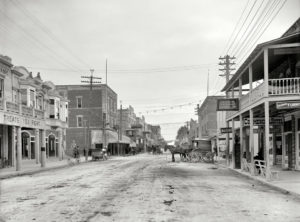A Special Moment in Time: Miami’s Crucible Year Part II
[AdSense-A]
As noted in our previous column, 1896 was the single most important year in the history of the tiny unincorporated village on the shores of Biscayne Bay as it transitioned to becoming a city without the intermediate steps of village or township.
The previous article introduced the first two events that gave the year 1896 its cachet as the crucible year in Miami’s incredible history: The arrival, on February 6, 1896, of Miami’s first permanent Jewish settler, Isidor Cohen and the arrival of the first work train and then the first passenger train of the Florida East Coast Railway, on April 15 and April 22, 1896, respectively were of immense importance in and to the formation of what would become the City of Miami. There were three more events to follow, however, each in its own way equally as important to the formation of said city.
On May 15, 1896, the people of the area awoke to find that that day would be the day of the publication of the first issue of what would shortly become Miami’s first newspaper, the Miami Metropolis. Begun to fill the need of a reliable printed news, advertising, commentary and opinion paper, the Metropolis would serve as the city’s only newspaper until 1903, when the Record (to later become The Miami Herald) would be published for the first time.
The Metropolis would have an illustrious career until 1925 when James M. Cox, the U. S. senator from Ohio, and his newspaper family would buy the Metropolis and change it’s name to the Miami News-Metropolis. Cox purchased the property at the intersection of Northeast Sixth Street and the Boulevard which extended west to Northeast Second Avenue adjacent to the Florida East Coast Railway. That location was the place which the FEC had chosen for its first station, primarily because of its proximity to the P & O Steamship Company’s docks directly across Biscayne Boulevard and it was on that site that Cox would build the Miami News tower, known today to newcomers as The Freedom Tower but to long time Miamians the building will always remain, in our hearts if not in our minds, the Miami News building. Eventually, the name of the paper was changed again and the title Metropolis was dropped from the masthead as the newspaper became The Miami Daily News.
The first major event—and the fourth in the soon-to-be a city’s history—following the first issue of the Metropolis—was the founding of the City of Miami on July 28, 1896. Lobbying furiously for incorporation were no few of the locals, supported by the Flagler people, who felt that an incorporated city would be in their best interests.
There were 502 adult males who were qualified to vote on that sultry summer day and, depending of whose account one reads, either 342, 343, 344, 345 or 350 of them voted “yes” to incorporation, no few of those voters being of the (as the word was then current) Negro persuasion. Within a few years the shamefulness of segregation would overtake the growing city, but for those first several years black people were an integral part of the area’s growth, including a strong and civic-minded community in Coconut Grove as well as the fabled D. A. Dorsey buying large amounts of downtown acreage.
Among the signers of the city’s charter was Roddy Burdine, Isidor Cohen, the Sewell Brothers, John and Everest, Frank Budge (he of hardware fame) and no few others whose names resonate in Miami’s great and now-122-year history. As of July 29, 1896, the City founded by Mr. Flagler, Mary and William Brickell and Julia Tuttle—the first city in America to have women as a major part of its founding—was one day old.
The fifth and capstone event of the year 1896 was the opening, on New Year’s Eve, of Mr. Flagler’s great and fabled Royal Palm Hotel on the banks of the Miami River. An incredible hostelry, especially given the then-rural conditions of the area in which it was built, the hotel would, until the 1926 hurricane devastated it, be the center of Miami’s social life and whirl and would be the meeting place (in the winter, of course, as the hotel, like all Flagler System hotels, closed early in April and did not reopen until just before Christmas) of and for most organizations and civic groups. Unhappily to report, however, the numerous (as the late, great Neil Rogers would call them) front—running phonies who did not grow up in, live in, go to school in or work in Greater Miami but blew into town to write a bunch of nonsensical hooey about the area would usually state the date of the opening to be sometime in 1897, which, like so much “they” write is completely false: the hotel absolutely, positively, unquestionably and documentedly opened on the last day of 1896 with a grand and gala opening night ball.
Suffice to say, while there have been other important years in Miami-Dade’s history, 1896 will always remain and be thought of one of the two unquestionably most important and we
[si-contact-form form=’2′]


